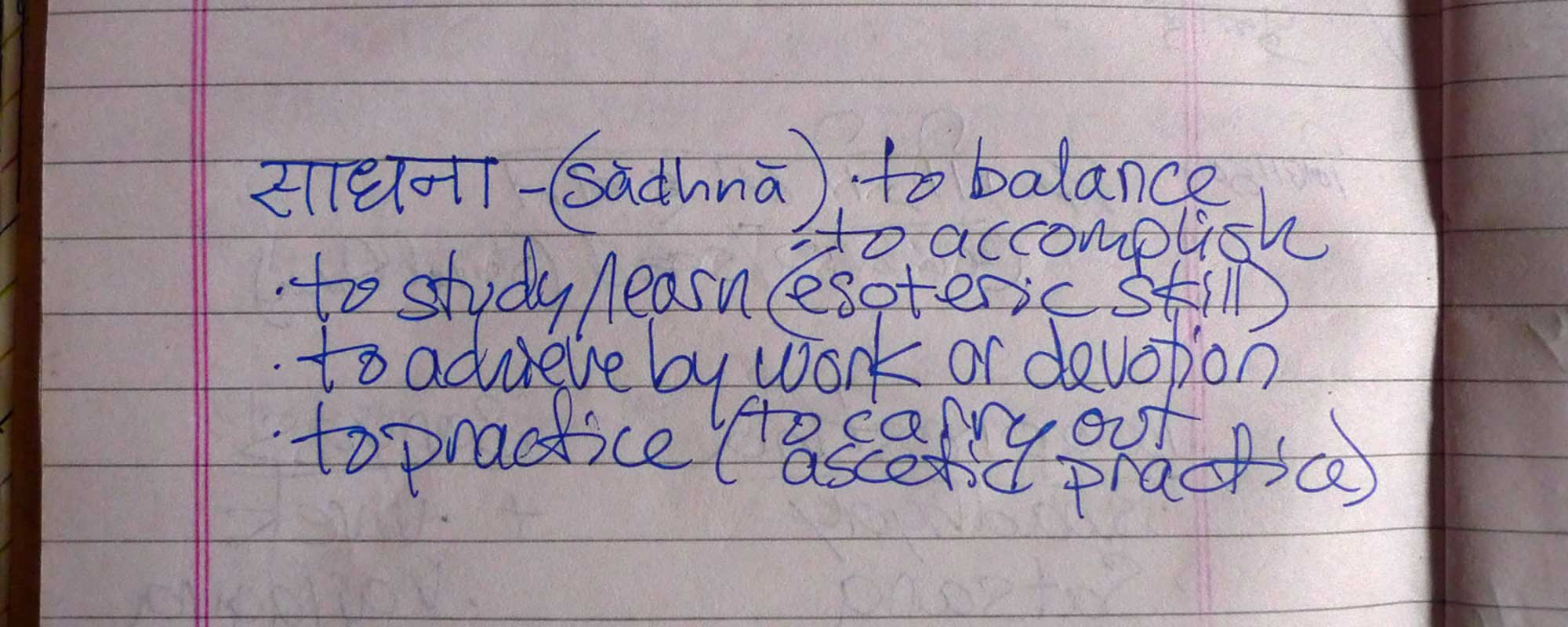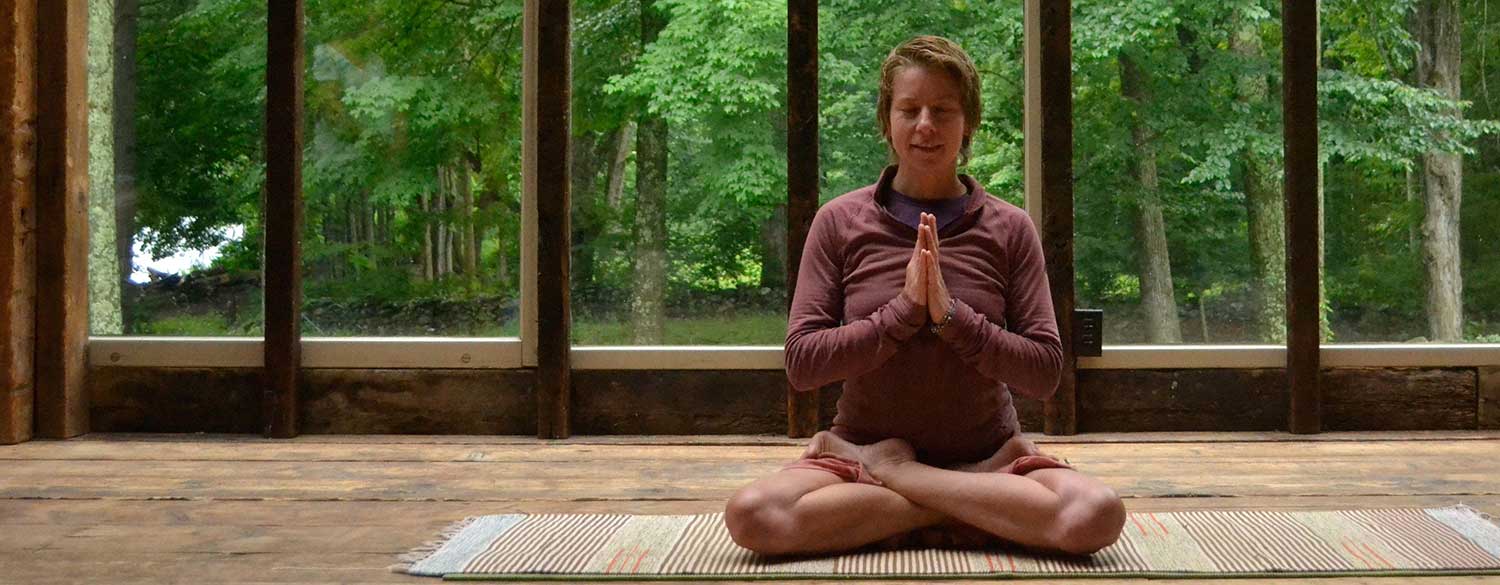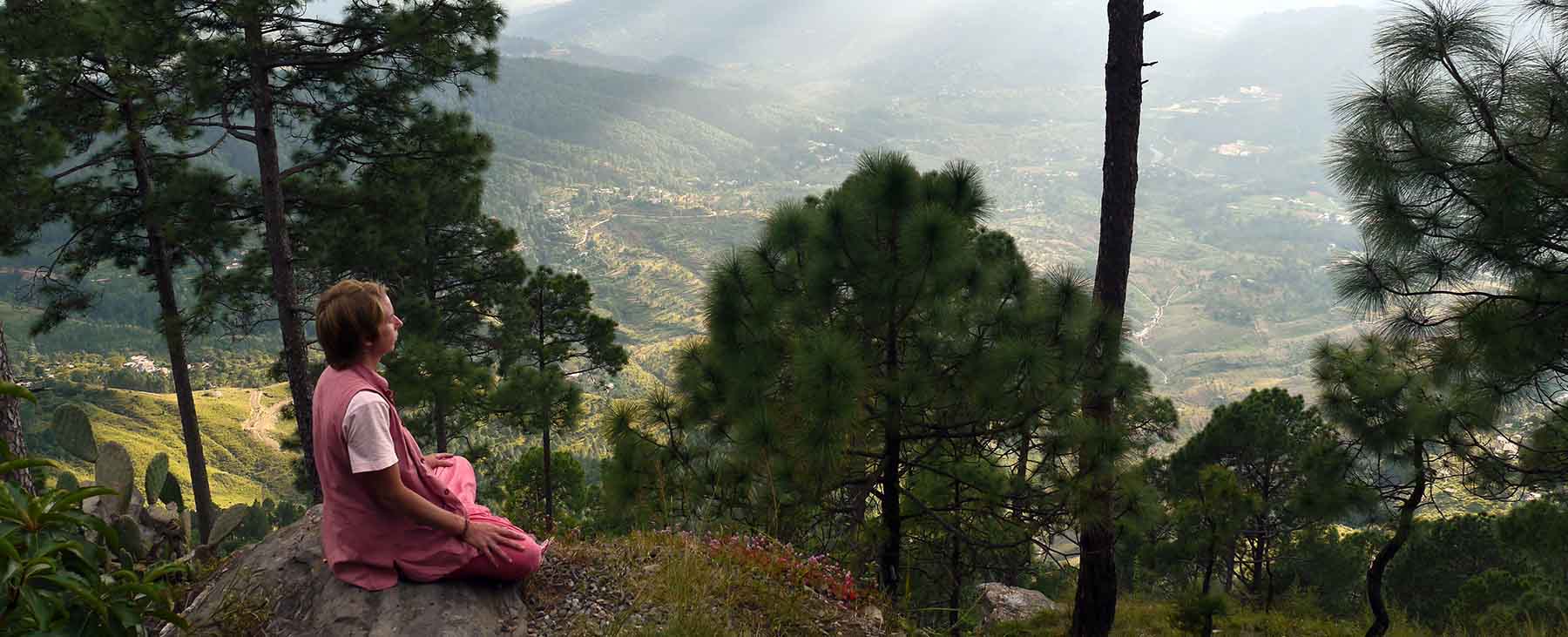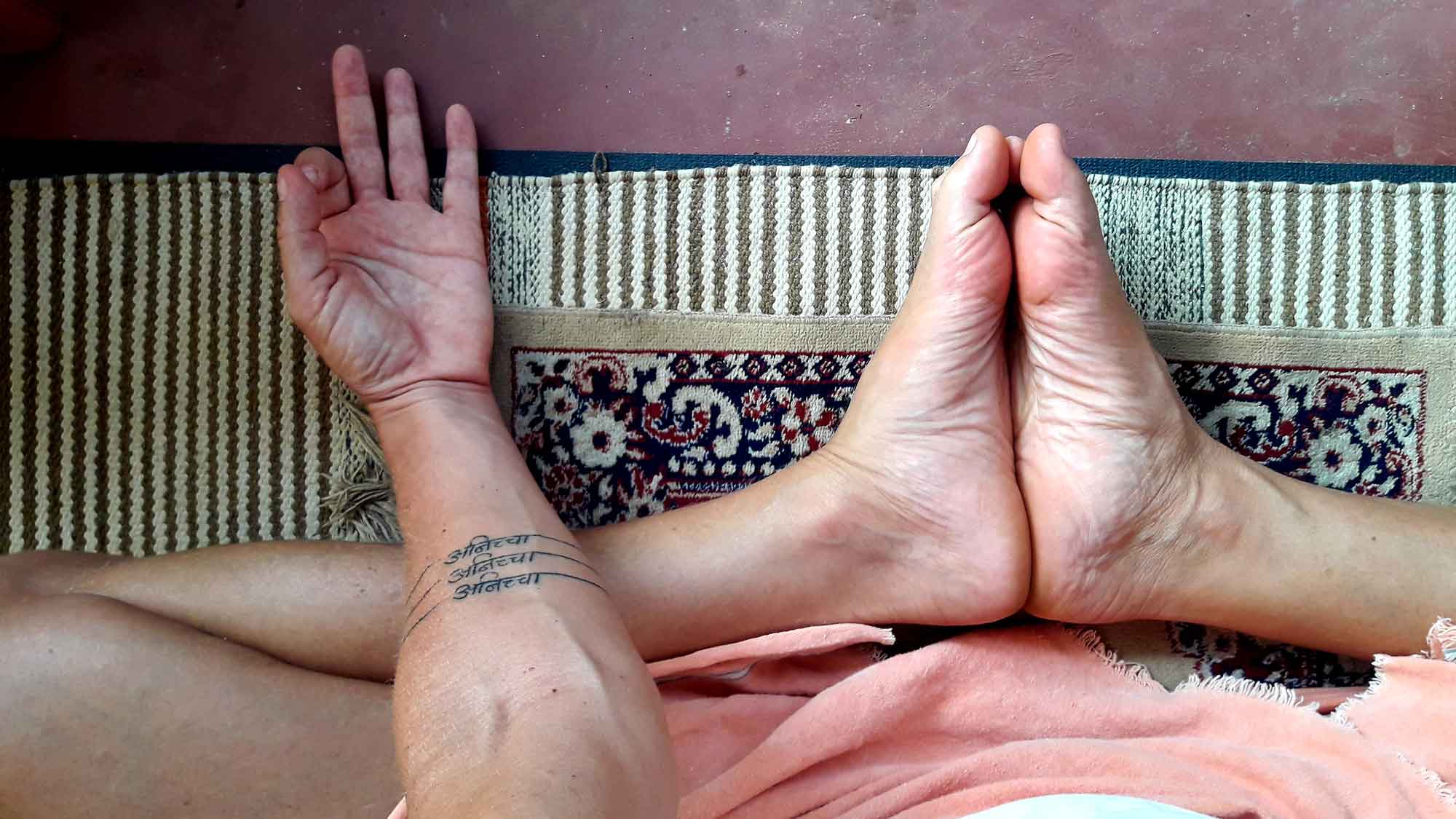My साधना कहानी sādhāna story / योग यात्रा yoga journey…
Stretching, breath / sensation awareness, and sitting still were practices I remember doing as young as 5 years old. Yet it was documentary filmmaking and photography that brought me to India in December 2000, giving me a context and language to define my yoga practice as साधना sādhāna. As my yoga journey evolved, actually doing sādhāna began to take precedence over documenting it. Because where as documentation is looking at the other, sādhāna is looking at oneself… eventually I had to put the camera down and turn the lens inwards.

My Sadhana Story / Yoga Journey began way before coming to India was even an idea…
I first was introduced to meditation and yoga nidra, albeit informally, as a child in early elementary school, perhaps aged 5 or so.
My parents were going through a divorce and I would have trouble sleeping, my mind spinning with thoughts, confused about what was happening to my family. I don’t remember who taught me or if I just began practicing on my own. In order to lure myself back to sleep, I’d lay on my back, eyes closed, and would begin to scan my body from head to toe and toe to head, feel and take notice of the sensations that arose and in my mind. I remember literally telling each part of my body to “relax”, while also focusing on my breathing. Breathe in, “Top of the head relax”. Breathe out, “Forehead relax”. Breathe in, “Eyes relax”. Breathe out, “Mouth relax”. Breathe in, “Neck relax”. Breathe out, “Shoulders relax”. Breathe in, “Upper back relax”. Breathe out, “Lower back relax”… Meandering my focus down my body… and back up again… Breathe in, “Toes relax”. Breathe out, “Ankles relax”. Breathe in, “Lower legs relax”. Breathe out, “Thighs relax”. Etc.
And it did help me relax, helped my chattering mind slow down and eventually get renewing sleep. For years I would do this most every night before bed. And however I had no vocabulary for which to call this practice, much less to describe how it evolved, after a while I do recall the sensations of expansion, feeling somewhat un-contained by my body, unable to perceive where my body was in relation to my surroundings, an almost out of body feeling; in retrospect I can imagine it was a sense of oneness, or at least that of approaching oneness.
Somewhere over the years this pre-sleep “relax” practice faded away.
However though out school I played a myriad of competitive sports. Initially I took up swimming, which I now consider very similar to pranayam as well as pratyahar. To be a proficient swimmer one much be aware of and able to control one’s breathing patterns. Being underwater or gliding on top of the water also allowed me to cut off some of my senses (specifically not hearing the distracting noise pollution of the outside world) and thus the greater awareness of other senses (my breath, my body’s movement, the spinning of my thoughts slowing down and eventually fading away). I always felt refreshed from a swimming session, mind more clear and focused than before I got into the pool.
Later through volleyball, something that was not innately easy for me as I was quite shorter than most I encountered on the court, I was taught by my coach to utilize visualization in my practice. Both on the drive to and from practice as well as at home before I went to sleep, I would visualize my jumping higher and higher, my serving, passing, setting, and hitting the ball to perfection. I do believe this not only helped me to be a better player, but also contributed toward the focusing of my mind.
By the summer after high school in 1993, a friend of mine re-introduced me to meditation, actually calling it by name and giving me a technique with which to sit.
We would sit together in front of the ocean or river and just breathe, as he instructed me to count the seconds it took me to inhale and exhale, with the breath control intention of slowing down one’s breathing. By college I joined a meditation group, which met once a week in the college chapel. We would sit in a circle on cushioned meditation stools (slightly elevated so we could rest our knees and shins comfortably on the ground below us without the pressure of the weight of our bodies) and just focus on our breath, not trying to control anything, but just being there. Here with my mind spinning with memories of class lectures, homework assignments, papers I have to compose, interactions I had with other classmates, etc. I learned to use meditation as a way to manage the stress of school and adolescence.
At this point in my consciousness development, I was doing the college-typical mind expansive experimentation, shifting my course of study toward philosophy and in my summer break bookstore perusals discovering books by authors like Ram Dass. But that same time I also recall being faced with a strange contradiction. Our Capitalist productive robot society, my mother and grandparents all stressed actually “doing something” and thus the seemingly non-activity of sitting around “doing nothing” was considered wasted time and thus not encouraged, at the very least misunderstood. Meditation on summer and winter holidays became like a taboo thing I did in secret, like smoking pot or watching queer films. And eventually it faded off as a practice, laying dormant for a few years.
December 2000 – May 2001 was my first venture to India, where I was initially introduced to the origins of yoga and meditation via the ascetics and other curious truth seeking foreigners, by whom I was surrounded during the Kumbh Mela.
In preparation for this trip I re-ignited my interest in meditation, as well as sparked a newer interest in a more formalized yoga (with athletics I was no stranger to long breath-full stretching sessions). And in those early post college years (prior to this trip) as my identity took one more turn in redefinition, my circle of friends also began shifting, surrounding myself with more conscious minded folk, among whom meditation and yoga were not uncommon.
Finally in India I was in the company of people who not only thought it was ok to just sit and breathe but also encouraged it, some even gained siddhis (powers) from it, many shared with us practical methods.
Perhaps it was staying near the Ganga, traveling to it’s source, sitting long hours in ancient temples, or all the energy left behind by those centuries before us having done their own tapasya at these very same places; what ever it was I was mesmerized to say the least. It was in India that I revisited those expansion feelings I had as a child through my “Hips relax.” methodology (of calming my mind’s chatter enough to finally sleep). It was in India that I first experienced really feeling out of the body as well as the feeling of none of this is actually new, like I’ve been here before.
I took back home with me the practice of Japa, turning a mala while reciting the mantra “Om Namah Shivaya”.
I found japa helped me strengthen my practice of being calm and mindful back in New York City, a city well known for stress and reactionary interactions with those one may encounter on over crowded subways or sidewalks. Since then I have also found meditation to be a relief from the initially excruciating pain I felt from two injuries (knee and back separately – more on this later). Through focusing my attention on other parts of my body that felt strong, unharmed, and healthy, I was able to not only send that positive healing energy to my injury, but also let go of the attachment to feeling this pain, as well as ultimately healing myself faster (as doctors and reiki masters have told me I did).
In January 2010 I had my first Vipassana course in Dehradun.
Vipaasana gave my prior experiences a vocabulary, words to describe a phenomenon about which I was already knowing, yet previously found difficult to articulate. Vipassana somewhat concretized for me the ideas in my mind I was pondering already, the ideas of non-attachment (to things, material, sensual, emotional) as well as non-expectations; it was indeed a solid reminder of the facts of this ever-changing world, that everything is impermanent. Most of all it provided a space for me to let go of mental-emotional-luggage I was not even aware of having stuffed deep inside.
Meditation has become a reminder of how free the mind can be once I let go of all the thoughts that once occupied it.

Frustrated with the yoga I was seeing in American yoga studios…
compared to what I experienced among the yogis I met at the Kumbh Melas, I was determined to learn from as close to source as I could.
Living at several ashrams throughout Uttarakhand,
I inherited (from one of my gurus) quite a library of old books, mostly yoga philosophy in Sanskrit with English or Hindi commentaries, by Indian Authors.
My sadhana story / yoga journey travels through those, almost secrete places, where guru / disciple relationships have nothing to do with earning certificates…
Otherwise aside from several Vipassana courses in India and Nepal, most of my real training has been living among sanyasi yogis with in the Śri Panch Daśnām Juna Akhara (the oldest and largest organization of ascetic renunciate yogis) and other Nāth Yogis, where guru / disciple relationships have nothing to do with earning certificates. And thus despite completing over 1000 hours of certificate trainings, I have many issues with the spiritual industrial complex, Yoga Alliance, and how capitalism’s infiltration in an ancient tradition has completely ruined it in the West / Global North. I take decolonizing yoga very seriously and am trying not to be a snob about it. Meanwhile I’ve been exploring the intersections of Yoga and Social Justice in a 75hour Skill in Action online course with Michelle C. Johnson.

Certificate Training:
Some of my other certificate trainings include:
Non-Certificate Training:
Deeper Study…
My Sadhana Story / Yoga Journey has evolved the following Specialties:
• Traditional seven limbed Hatha Yoga system: śatkarma (seasonal and daily cleansing and detoxes), āsana (postures), mudrā (gestures for connecting one’s individual prāṇic flow with the universal or cosmic force), pratyāhār (concentration towards removal of disturbance from sensory input), prāṇāyāma (expansion of the breath and prāṇa / vital energy), meditation (uninterrupted blissful flow of prāṇic energy), and ultimate samādhi (complete balance of the mind in all situations);
• Sūkṣma Vyāyām (subtle pranic exercises, aka Himalayan Yoga);
• Vipassana Meditation (as taught by S.N. Goenka);
• Yogic / Sanātan Dharmic / Buddhist Philosophy;
• Karma Yoga (seva – selfless service towards others, without concern or attachment to the fruits of one’s labor);
• Svadhāya (independent study and introspective study of the self);
• Yoga / Sadhana that is trauma informed, queer, non-binary and inclusive.


